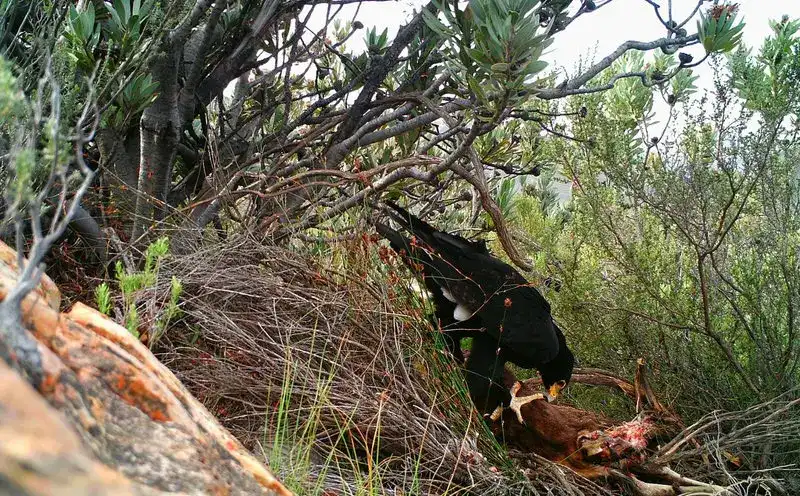Cape Town, August 20, 2018
In the wild, sightings of Black Eagles are a rare and special event. These magnificent raptors are renowned for their solitary and elusive nature, making their appearance on the reserve even more cherished and memorable. With their native habitat spanning the southern and eastern regions of Africa, the presence of Black Eagles is said to indicate a thriving and balanced ecosystem, adding significance to each sighting as a cause for celebration.
Recently, at Aquila Private Game Reserve, a dedicated team set up a Cape Leopard monitoring programme. Placing cameras strategically at the sites of recent kills made by the reserve’s nocturnal and endangered Cape Mountain Leopards. Hoping to gather crucial data for ongoing observation and research on Aquila’s resident leopard population, cameras were set up near three carcasses of Blesbok in the last month, providing valuable insights into the leopards’ hunting behaviour.
However, what awaited them in the camera trap footage surpassed all expectations! In an unexpected twist, the cameras captured a breathtaking scene – two pristine Black Eagles, presumed to be a mated pair, feasting leisurely on the leopard’s prey. Searl Derman, owner and founder of Aquila, couldn’t contain his delight when he viewed the footage. This astonishing scene not only highlights the importance of preserving the reserve’s natural ecosystem, but reinstates the significance of maintaining a safe and thriving environment for Cape Town’s wild animal population.
In the wild, sightings of Black Eagles are a rare and special event. These magnificent raptors are renowned for their solitary and elusive nature, making their appearance on the reserve even more cherished and memorable. With their native habitat spanning the southern and eastern regions of Africa, the presence of Black Eagles is said to indicate a thriving and balanced ecosystem, adding significance to each sighting as a cause for celebration.
Recently, at Aquila Private Game Reserve, a dedicated team set up a Cape Leopard monitoring programme. Placing cameras strategically at the sites of recent kills made by the reserve’s nocturnal and endangered Cape Mountain Leopards. Hoping to gather crucial data for ongoing observation and research on Aquila’s resident leopard population, cameras were set up near three carcasses of Blesbok in the last month, providing valuable insights into the leopards’ hunting behaviour.

However, what awaited them in the camera trap footage surpassed all expectations! In an unexpected twist, the cameras captured a breathtaking scene – two pristine Black Eagles, presumed to be a mated pair, feasting leisurely on the leopard’s prey. Searl Derman, owner and founder of Aquila, couldn’t contain his delight when he viewed the footage. This astonishing scene not only highlights the importance of preserving the reserve’s natural ecosystem, but reinstates the significance of maintaining a safe and thriving environment for Cape Town’s wild animal population.

The Black Eagle (Aquila verreauxii), also known as the Verreaux’s Eagle, is a large bird of prey found in certain regions of Africa. It is a stunning raptor with distinctive features that make it easily identifiable.
Size: Black Eagles have a spectacular wingspan that can reach up to 2.3 meters (7.5 feet) and a length of about 75-96 cm (30-38 inches).
Coloration: Despite the common name “Black Eagle,” these birds are not entirely black. They have a mostly dark brown to black plumage with a white V-shaped mark on the lower back, visible when they are in flight. The underwing coverts are white, and the tail has a broad black band towards the tip. Black Eagles also have a distinctive double crest on the back of their head. This feature helps in distinguishing them from other eagle species in their range.
Habitat: Black Eagles are primarily found in hilly and mountainous regions of sub-Saharan Africa. They prefer forests, woodlands, and rocky cliffs in highland areas.
Flight pattern: Black Eagles are agile and powerful fliers. When soaring, they often hold their wings in a slight dihedral (V-shape) and use thermal currents to gain altitude with minimal wing flapping. They are known for their solitary nature and tend to be quite secretive, making them challenging to spot in the wild. They are highly territorial and use vocalisations and aerial displays to defend their nesting sites.
Range: The Black Eagle’s range includes parts of southern and eastern Africa, from South Africa to Kenya and Tanzania.

Help us save Africa’s wildlife heritage!
Make a donation of your choice to support our conservation initiatives and rehabilitation projects.
© Copyright ARC (Animal Rescue Centre, Aquila Collection).